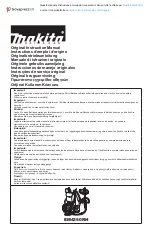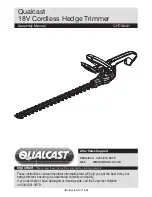
24
English(Original instructions)
WARNING :
Keep all bystanders, especially children and pet,
at least 15m away.
WARNING:
Do not use any attachments or accessories
not recommended by the manufacturer of this
product. The use of attachments or accessories
not recommended can result in serious personal
injury.
WARNING:
Beware of the emission of exhaust gases.
FUELING AND REFUELING
Ŷ
Clean the surface around the fuel cap to prevent
contamination.
Ŷ
Loosen the fuel cap slowly. Rest the cap on a clean
surface.
Ŷ
Pour the fuel carefully into the tank. Avoid spillage.
Ŷ
Clean and inspect the gasket prior to replacing the
fuel cap.
Ŷ
Replace the fuel cap immediately and hand tighten it.
Wipe up any fuel spillage.
NOTE
: It is normal for the engine to emit smoke during
and after the first use.
WARNING:
Always shut the engine off before fueling. Never
add fuel to a machine with a running or hot engine.
Move at least 10m away from refueling site before
starting engine. Do not smoke! Failure to heed this
warning could result in serious personal injury.
OXYGENATED FUELS
Some conventional petrols are blended with alcohol or
an ether compound. This type of petrol is collectively
referred to as oxygenated fuels.
If using an oxygenated fuel, make sure it is unleaded
and meets the minimum octane rating requirements.
Before using an oxygenated fuel, try to confirm the fuel’s
contents. Some areas require this information to be
posted on the pump. The following are the EPA approved
percentages of oxygenates:
Ethanol (ethyl or grain alcohol) 10% by volume.
You
may use petrol containing up to 10% ethanol by volume.
Petrol containing ethanol may be marketed under the
name “Gasohol.”
Do not use E85 fuel.
MTBE (methyl tertiary butyl ether) 15% by volume.
You may use petrol containing up to 15% MTBE by
volume.
Methanol (methyl or wood alcohol) 5% by volume.
You may use petrol containing up to 5% methanol by
volume as long as it also contains co solvents and
corrosion inhibitors to protect the fuel system. Petrol
containing more than 5% methanol by volume may
cause starting and/or performance problems. It may
also damage metal, rubber, and plastic parts of the
product or your fuel system. If you notice any undesirable
operating symptoms, try another service station or switch
to another brand of Petrol.
NOTE:
Fuel system damage or performance problems
resulting from the use of an oxygenated fuel containing
more than the percentages of oxygenates stated
previously are not covered under warranty.
ADDING/CHECKING ENGINE LUBRICANT
See Figure 17 for RBC430SESC
See Figure 18 for RBC430SBSC
Engine lubricant has a major influence on engine
performance and service life. For general, all-
temperature use, SAE 20W-50 is recommended. Always
use a 4-stroke motor lubricant that meets or exceeds the
requirements.
NOTE:
Non-detergent or 2-stroke engine lubricants will
damage the engine and should not be used.
To add engine lubricant:
Ŷ
Remove the cap and seal from lubricant bottle
provided.
Ŷ
Unscrew the oil cap/dipstick and remove.
Ŷ
Using the funnel provided, add the entire bottle of
engine lubricant through oil fill hole.
Ŷ
Reinstall the oil cap/dipstick and secure.
To check engine lubricant level:
Ŷ
Set engine on a flat surface unscrew the oil cap/
dipstick and remove.
Ŷ
Wipe the dipstick clean and re-seat in hole; do not
re-screw.
Ŷ
Remove dipstick again and check lubricant level.
Lubricant level should fall within the hatched area on
the dipstick.
Ŷ
If level is low, add engine lubricant until the fluid level
rises to the upper portion of the hatched area on the
dipstick.
Ŷ
Replace and secure the oil cap/dipstick.
CAUTION:
Do not overfill. Overfilling the crankcase may
cause -excessive smoke and engine damage.
OPERATING THE BRUSHCUTTER / TRIMMER
See Figure 8. 7a.7b for RBC430SESC
WARNING:
Always position the unit on the operator’s right
side. The use of the unit on the operator’s left
side will expose the user to hot surfaces and can
result in possible burn injury.
















































